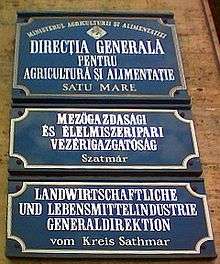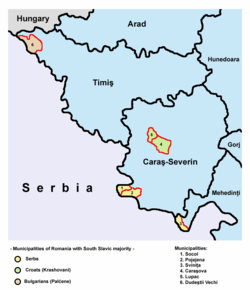Languages of Romania
| Languages of Romania[1] | |
|---|---|
| Official languages | Romanian (>90%) |
| Minority languages | Hungarian, Romani, Ukrainian, German, Serbian, Russian, Croatian, Slovak, Bulgarian, Turkish |
| Main foreign languages |
English (29%) French (24%) Italian (7%) German (6%) |
| Sign languages | Romanian Sign Language |
| Part of a series on the |
| Culture of Romania |
|---|
 |
| History |
|
Festivals |
|
|
Music and performing arts |
| Sport |
|
Organisations |
|
In Romania there are several spoken languages. Beside Romanian, the only official language nationwide, other spoken languages include Hungarian, English, Lithuanian, Bulgarian, Serbo-Croatian, Russian, Slovak, Romani, Ukrainian, and German.
Official language
According to the 2002 Romanian Census, Romanian is spoken by 91% of the population as a primary language. According to the Romanian Constitution [2] and the law 1206 of 2006 [3] the only official language in Romania is the Romanian Language both at national and local level.
Minority languages
After the fall of Romania's communist government in 1989, the various minority languages have received more rights, and Romania currently has extensive laws relating to the rights of minorities to use their own language in local administration and the judicial system.
While Romanian is the only official language at the national and local level, there are 14 other living languages in Romania.[4] The Romanian laws include linguistic rights for all minority groups that form over 20% of a locality's population. This includes the adoption of signage in minority languages, access to local administration and justice systems, the right to receive education in that language, and a series of other rights.
Hungarian
Hungarian is the largest minority language in Romania: the 2002 census listed 1,447,544 native Hungarian speakers in the country, or 6.7% of the total population. This minority largely lives in Transylvania, which was part of the Kingdom of Hungary until 1918 (Northern Transylvania was part of Hungary again between 1940 and 1947) though there are Hungarian speaking minorities in other parts of the country as well.
Romani

Roma make up the second largest minority in Romania and 241,617 Romani speakers were reported in the 2002 census, or 1.1% of the total population. Dialects of Romani spoken include Balkan Romani, Vlax Romani, and Carpathian Romani. Romani is used in local signage, administration, education and justice in 79 communes and one town (Budești).
Ukrainian
There are 57,593 Ukrainian speakers in Romania, mostly concentrated in Maramureș County, where they make up 6.67% of the population, but also in Suceava and Timiș counties. Ukrainians make up the majority in four communes: Bistra, Maramureș, Rona de Sus, Știuca and Copăcele.
German

There are many different groups of Germans in Romania, the largest of whom have historically been known as the Transylvania Saxons and the Banat Swabians. Germans once constituted a much larger portion of the Romanian population than they do today, though they are still the fourth largest ethno-linguistic group. In 1938 there were 780,000, and in 1992 there were 111,301, but the 2002 census reported only 45,129 Germans. Since 1989 they have been represented by the Democratic Forum of Germans in Romania, which functions in the German language.
Russian

There are 29,890 Lipovans, ethnically Russian emigrants from the Russian Empire who left because of religious differences with the Russian Orthodox Church, in Romania. They mostly speak the Russian language, and most live in Tulcea County.
Turkic languages
Turkish
Turkish speakers make up 0.1% of the population, with a community of some 28,714 speakers. The Turkish speaking community is largely a legacy of the Ottoman rule of a large part of Romania. They live in the southern parts of Romania (Dobrudja).
Tatar
Tatars also make up roughly 0.1% of the Romanian population, with a community of 21,482 speakers. Most, Crimean Tatars, speak the Crimean Tatar language, and the greater part of the community lives in Constanța County.
Other languages

Lesser spoken languages in Romania include: Serbo-Croatian (26,732: 20,377 Serbians, 6,355 Croatians), Slovak (16,108), Bulgarian (6,747), Greek (4,146).
References
- ↑ "Europeans and their Languages" (PDF). Ec.europa.eu. December 2005. Retrieved 2016-01-28.
- ↑ "Constitutia României". Cdep.ro. Retrieved 2016-01-28.
- ↑ Archived February 21, 2007, at the Wayback Machine.
- ↑ "Romania : Languages of Romania". Ethnologue.com. 1999-02-19. Retrieved 2016-01-28.
External links
- Ethnologue report for Romania
- (Romanian) Romanian National Census 2002, POPULATIA DUPA LIMBA MATERNA section
| Wikimedia Commons has media related to Languages of Romania. |